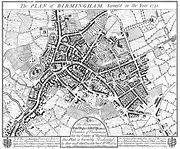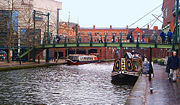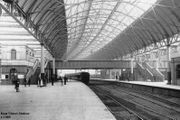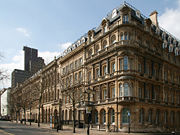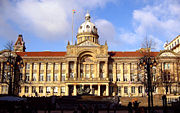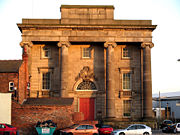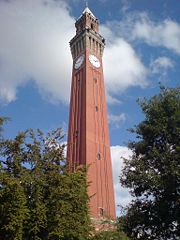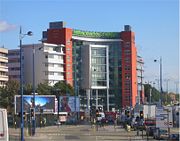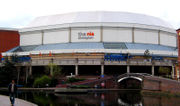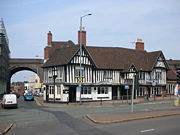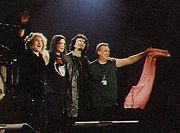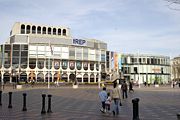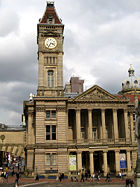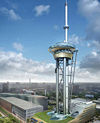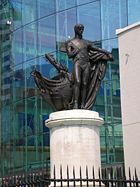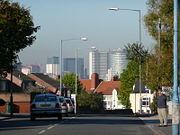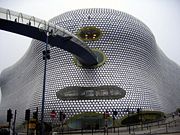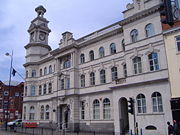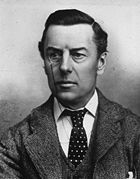Birmingham
2008/9 Schools Wikipedia Selection. Related subjects: British Cities; Great Britain
| City of Birmingham | |||
| Birmingham's skyline viewed from the east | |||
|
|||
| Nickname(s): "Brum", "Brummagem", "Second City", "Workshop of the World", "City of a Thousand Trades" | |||
| Motto: Forward | |||
| Birmingham shown within England and the West Midlands | |||
| Coordinates: | |||
|---|---|---|---|
| Sovereign state | United Kingdom | ||
| Constituent country | England | ||
| Region | West Midlands | ||
| Ceremonial county | West Midlands | ||
| Admin HQ | Birmingham City Centre | ||
| Founded | 6th century | ||
| Municipal borough | 1838 | ||
| City | 1889 | ||
| Government | |||
| - Type | Metropolitan borough | ||
| - Governing body | Birmingham City Council | ||
| - Lord Mayor | Randal Brew | ||
| - Council Leader | Mike Whitby (C) | ||
| - Council Control | Conservative / Liberal Democrat | ||
| - MPs | Richard Burden (L) Liam Byrne (L) John Hemming (LD) Dr Lynne Jones (L) Khalid Mahmood (L) Steve McCabe (L) Andrew Mitchell (C) Clare Short (IL) Siôn Simon (L) Gisela Stuart (L) |
||
| Area | |||
| - Total | 103.4 sq mi (267.77 km²) | ||
| Elevation | 459 ft (140 m) | ||
| Population (2005 est.) | |||
| - Total | 1,006,500 ( Ranked 1st) | ||
| - Density | 9,684/sq mi (3,739/km²) | ||
| - Conurbation | 2,284,093 | ||
| - Ethnicity (2005 estimates) |
67.8% White 3.1% Mixed 20.4% S.Asian 6.6% Black 1.1% Chinese 1.1% Other |
||
| Time zone | Greenwich Mean Time ( UTC+0) | ||
| - Summer ( DST) | British Summer Time ( UTC+1) | ||
| Postcode | B | ||
| Area code(s) | 0121 | ||
| ISO 3166-2 | GB-BIR | ||
| ONS code | 00CN | ||
| OS grid reference | SP066868 | ||
| NUTS 3 | UKG31 | ||
| Website: www.birmingham.gov.uk | |||
Birmingham ( pronunciation ; IPA: /ˈbɜːmɪŋəm/; Burr-ming-um) is a city and metropolitan borough in the West Midlands county of England. Birmingham is the largest of England's core cities, and is often considered to be the second city of the United Kingdom. The City of Birmingham has a population of 1,006,500 (2006 estimate). It forms part of the larger West Midlands conurbation, which has a population of 2,284,093 (2001 census) and includes several neighbouring towns and cities, such as Solihull, Wolverhampton and the towns of the Black Country.
The city's reputation was forged as a powerhouse of the Industrial Revolution in England, a fact which led to Birmingham being known as "the workshop of the world" or the "city of a thousand trades". Although Birmingham's industrial importance has declined, it has developed into a national commercial centre, being named as the third best place in the United Kingdom to locate a business, and the 21st best in Europe by Cushman & Wakefield in 2007. It is also the fourth most visited city by foreign visitors in the UK. In 1998, Birmingham hosted the G8 summit at the International Convention Centre, the birthplace of exhibitions in 1850 and remains a popular location for conventions today.
People from Birmingham are known as ' Brummies', a term derived from the city's nickname of Brum. This comes in turn from the city's dialect name, Brummagem, which is derived from one of the city's earlier names, 'Bromwicham'. There is a distinctive Brummie dialect (distinct vocabulary and syntax) and accent, both of which differ from the adjacent Black Country.
History
In the 6th century, Birmingham was an Anglo-Saxon farming hamlet on the banks of the River Rea. The name 'Birmingham' comes from "Beorma ingas ham", meaning "home of the people of Beorma." Birmingham was first recorded in written documents by the Domesday Book of 1086 as a small village, worth only 20 shillings. There were many variations on this name. Bermingeham is another version.
In the 12th century, Birmingham was granted a royal charter to hold a market, which in time became known as the Bull Ring, transforming Birmingham from a village to a market town. As early as the 16th century, Birmingham's access to supplies of iron ore and coal meant that metalworking industries became established.
By the time of the English Civil War in the 17th century, Birmingham had become an important manufacturing town with a reputation for producing small arms. Arms manufacture in Birmingham became a staple trade and was concentrated in the area known as the Gun Quarter. During the Industrial Revolution (from the mid-18th century onwards), Birmingham grew rapidly into a major industrial centre and the town prospered. During the 18th century, Birmingham was home to the Lunar Society, an important gathering of local thinkers and industrialists.
By the 1820s, an extensive canal system had been constructed, giving greater access to natural resources to fuel to industries. Railways arrived in Birmingham in 1837 with the arrival of the Grand Junction Railway, and a year later, the London and Birmingham Railway. During the Victorian era, the population of Birmingham grew rapidly to well over half a million and Birmingham became the second largest population centre in England. Birmingham was granted city status in 1889 by Queen Victoria. The city established its own university in 1900.
Birmingham was originally part of Warwickshire, but expanded in the late 19th and early 20th centuries, absorbing parts of Worcestershire to the south and Staffordshire to the north and west. The city absorbed Sutton Coldfield in 1974. The people of Sutton Coldfield still consider themselves separate from Birmingham. At the same time Birmingham became a metropolitan borough in the new West Midlands county. Up until 1986, the West Midlands County Council was based in Birmingham City Centre.
Birmingham suffered heavy bomb damage during World War II's " Birmingham Blitz", and the city was extensively redeveloped during the 1950s and 1960s. This included the construction of large tower block estates, such as Castle Vale in Erdington. The Bull Ring reconstructed and New Street station was redeveloped. In recent years, Birmingham has been transformed, with the construction of new squares like Centenary Square and Millennium Place. Old streets, buildings and canals have been restored, the pedestrian subways have been removed, and the Bull Ring shopping centre has been redeveloped further.
In the decades following The Second World War, the population of Birmingham changed dramatically, with immigration from the Commonwealth of Nations and beyond. The population peaked in 1951 at 1,113,000 residents.
Geography
Birmingham is situated just to the west of the geographical centre of England on the Birmingham Plateau - an area of relatively high ground, ranging around 500 to 1,000 feet (150-300 m) above sea level and crossed by Britain's main north-south watershed between the basins of the Rivers Severn and Trent. To the south and west of the city lie the Lickey Hills, Clent Hills and Walton Hill, which reach 1,033 feet (315 m) and have extensive views over the city. Birmingham is located in the centre of the West Midlands region of England.
Geology
Geologically, Birmingham is dominated by the Birmingham Fault which runs diagonally through the city from the Lickey Hills in the south west, passing through Edgbaston, the Bull Ring and Erdington, to Sutton Coldfield in the north east. To the south and east of the fault the ground is largely softer Keuper Marl, interspersed with beds of Bunter pebbles and crossed by the valleys of the Rivers Tame, Rea and Cole along with their tributaries. Much of this would have been laid down during the Permian and Triassic eras. To the north and west of the fault, varying from 150 to 600 feet (45-180 m) higher than the surrounding area and underlying much of the city centre, lies a long ridge of harder Keuper Sandstone.
Much of the area now occupied by the city was originally a northern reach of the ancient Forest of Arden, whose former presence can still be felt in the city's dense oak tree-cover and in the large number of districts such as Moseley, Saltley and Hockley with names ending in "-ley": an Anglo-Saxon word meaning "woodland clearing".
Climate
The climate in Birmingham is classified as a temperate maritime climate, like much of the British Isles, with average maximum temperatures in summer (July) being around 20°C (68°F); and in winter (January) is around 4.5°C (40°F). Extreme weather is rare but the city has been known to experience tornados - the most recent being in July 2005 in the south of the city, damaging homes and businesses in the area.
Occasional summer heatwaves, such as the one experienced in July 2006 have become more common in recent years, and winters have become milder since the 1990s with snow becoming much less frequent. Similar to most other large cities, Birmingham has a considerable ' urban heat island' effect. During the coldest night recorded in Birmingham (14 January, 1982), for example, the temperature fell to -20.8°C (-5.4°F) at Birmingham International Airport on the city's eastern edge, but just -12.9°C (8.8°F) at Edgbaston, near the city centre. Relative to other large UK conurbations, Birmingham is a snowy city, due to its inland location and comparatively high elevation. Snow showers often pass through the city via the Cheshire gap on North Westerly airstreams, but can also come off the North sea from North Easterly airstreams.
| Weather averages for Birmingham | |||||||||||||
|---|---|---|---|---|---|---|---|---|---|---|---|---|---|
| Month | Jan | Feb | Mar | Apr | May | Jun | Jul | Aug | Sep | Oct | Nov | Dec | |
| Average high °C (°F) | 6.0 (43) | 6.2 (43) | 8.9 (48) | 11.9 (53) | 15.3 (60) | 18.8 (66) | 20.6 (69) | 20.1 (68) | 17.6 (64) | 13.8 (57) | 9.2 (49) | 7.1 (45) | |
| Average low °C (°F) | 0.3 (33) | 0.1 (32) | 1.5 (35) | 3.3 (38) | 6.0 (43) | 9.2 (49) | 11.1 (52) | 10.8 (51) | 8.8 (48) | 6.2 (43) | 2.9 (37) | 1.3 (34) | |
| Precipitation mm (inches) | 56 (2.2) | 48 (1.89) | 52 (2.05) | 48 (1.89) | 55 (2.17) | 57 (2.24) | 47 (1.85) | 67 (2.64) | 54 (2.13) | 53 (2.09) | 59 (2.32) | 66 (2.6) | |
| Source: United Nations World Meteorological Organization 2007-08-26 | |||||||||||||
| Weather averages for Birmingham | |||||||||||||
|---|---|---|---|---|---|---|---|---|---|---|---|---|---|
| Month | Jan | Feb | Mar | Apr | May | Jun | Jul | Aug | Sep | Oct | Nov | Dec | |
| Average high °C (°F) | 7 (45) | 8 (46) | 10 (50) | 13 (55) | 17 (63) | 19 (66) | 21 (70) | 22 (72) | 19 (66) | 14 (57) | 10 (50) | 7 (45) | |
| Average low °C (°F) | 3 (37) | 3 (37) | 4 (39) | 5 (41) | 8 (46) | 10 (50) | 12 (54) | 12 (54) | 11 (52) | 8 (46) | 5 (41) | 3 (37) | |
| Precipitation mm (inches) | 67.8 (2.67) | 46.8 (1.84) | 43.9 (1.73) | 64.6 (2.54) | 40.6 (1.6) | 62.0 (2.44) | 44.8 (1.76) | 65.3 (2.57) | 64.6 (2.54) | 121.0 (4.76) | 70.2 (2.76) | 70.6 (2.78) | |
| Source: Msn weather 2008-06-08 | |||||||||||||
Nearby places
- Cities
- Coventry
- Lichfield
- Wolverhampton
- Worcester
- Towns
- Aldridge
- Atherstone
- Bedworth
- Bromsgrove
- Cannock
- Coleshill
- Droitwich
- Dudley
- Halesowen
- Hinckley
- Kenilworth
- Kidderminster
- Nuneaton
- Oldbury
- Redditch
- Royal Leamington Spa
- Rugby
- Solihull
- Stafford
- Stourbridge
- Stratford-upon-Avon
- Tamworth
- Telford
- Warwick
- Walsall
- West Bromwich
- Villages
- Little Aston
- Streetly
See also: The Black Country.
Demographics
| Religion | Percentage of population |
|---|---|
| Buddhist | 0.3% |
| Christian | 59.1% |
| Hindu | 2% |
| Jewish | 0.2% |
| Muslim | 14.3% |
| Sikh | 2.9% |
| No religion | 12.4% |
| No answer | 8.4% |
Birmingham is an ethnically and culturally diverse city. In 2005 the ONS estimated that 67.8% of the population was White (including 2.7% Irish & 2.1% Other White), 20.4% Asian or Asian British, 6.6% Black or Black British, 1.1% Chinese, 3.1% of mixed race and 1.1% of other ethnic heritage. 57% of primary and 52% of secondary pupils are from non-white British families. 16.5% of the population was born outside the United Kingdom.
The population density is 9,451 inhabitants per square mile (3,649/km²) compared to the 976.9 inhabitants per square mile (377.2/km²) for England. Females represented 51.6% of the population whilst men represented 48.4%. More women were 70 or over. 60.4% of the population was aged between 16 and 74, compared to 66.7% in England as a whole.
60.3% of households were found to be owner occupied and 27.7% were rented from either the city council, housing association or other registered social landlord. The remaining 11.8% of households were rented privately or lived rent free.
Places of interest
The Birmingham Museum & Art Gallery is the main art gallery and museum in Birmingham. It has renowned displays of artwork that include a leading collection of work by the Pre-Raphaelite Brotherhood and the world's largest collection of works by Edward Burne-Jones. The group also owns other museums in the city such as Aston Hall, Blakesley Hall, the Museum of the Jewellery Quarter and Sarehole Mill, a popular attraction for fans of J. R. R. Tolkien. Thinktank in the Eastside is one of the newest museums in the city. The Birmingham Back to Backs are the last surviving court of back-to-back houses in the city.
The Barber Institute of Fine Arts is both an art gallery and concert hall. It also has one of the world's most detailed and largest coin collections. Cadbury World is a museum showing visitors the stages and steps of chocolate production and the history of chocolate and the company.
There are over 8,000 acres (3,200 ha) of parkland open spaces in Birmingham. The largest of the parks is Sutton Park covering 2,400 acres (970 ha) making it the largest urban nature reserve in Europe. Birmingham Botanical Gardens are a Victorian creation, with a conservatory and bandstand, close to the city centre. The Winterbourne Botanic Garden, maintained by the University of Birmingham, is also located close to the city centre. Woodgate Valley Country Park is in Bartley Green and Quinton.
The city centre consists of numerous public squares including Centenary Square, Chamberlain Square and Victoria Square. The historic Old Square is located on Corporation Street. Rotunda Square and St Martin's Square are two of the newest squares in Birmingham, being located within the Bullring Shopping Centre. Brindleyplace also consists of three squares.
Due to Birmingham's diverse population, there is a diverse variety of religious buildings in the city. St Philip's was upgraded from church to cathedral status in 1905. Another cathedral in the city is St Chad's, which is the seat of the Roman Catholic Province of Birmingham. St Martin in the Bull Ring is a Grade II* listed church. There is also a variety of non-Christian religions in the city. In the 1960s, Birmingham Central Mosque, one of the largest mosques in Europe, was constructed for the Muslim community of the city. However, during the late 1990s a mosque in the Sparkhill area close to the city centre was re-developed in partnership with the Birmingham City Council to supersede the Birmingham Central Mosque as the largest Mosque in the city. It holds a larger capacity and a fully functional segregated women's section. As its centrepiece is a dome. The new mosque is generally home to the Kashmiri-Pakistani population which made Birmingham its home during the late 1960s.
See also: Religion in Birmingham.
Economy
Although Birmingham grew to prominence as a manufacturing and engineering centre, its economy today is dominated by the service sector, which in 2003 accounted for 78% of the city's economic output and 97% of its economic growth.
Two of Britain's " big four" banks were founded in Birmingham - Lloyds Bank (now Lloyds TSB) in 1765 and the Midland Bank (now HSBC Bank plc) in 1836 - and today the city employs 108,000 in banking, finance and insurance. In 2007, Cushman & Wakefield stated that Birmingham was the third best place in the United Kingdom to locate a business, and the 21st best in Europe.
Tourism is also an increasingly important part of the local economy. With major facilities such as the International Convention Centre and National Exhibition Centre the Birmingham area accounts for 42% of the UK conference and exhibition trade. The city's sporting and cultural venues attract large numbers of visitors.
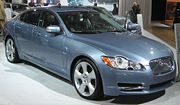
With an annual turnover of £2.2bn, Birmingham city centre is the UK's second largest retail centre, with the country's busiest shopping centre - the Bullring - and the largest department store outside London - House of Fraser on Corporation Street. The City also has one of only four Selfridges department stores, and the second largest branch of Debenhams in the country.
Despite the decline of manufacturing in the city several significant industrial plants remain, including Jaguar Cars in Castle Bromwich and Cadbury Trebor Bassett in Bournville.
Although the city has seen economic growth greater than the national average in the 21st century the benefits have been uneven, with commuters from the surrounding area obtaining many of the more skilled jobs. The two parliamentary constituencies with the highest unemployment rates in the UK - Ladywood and Sparkbrook and Small Heath - are both in inner-city Birmingham. Growth has also added to stresses on the city's transport. Many major roads and the central New Street railway station operate over capacity at peak times.
Politics
Birmingham City Council is the largest local authority in the UK and the largest council in Europe. It has 120 councillors representing 40 wards. No single party is in overall control and the council is run by a Conservative/ Liberal Democrat coalition. Birmingham's eleven parliamentary constituencies are represented in the House of Commons by one Conservative, one Liberal Democrat, one Independent Labour and eight Labour MPs. Birmingham City Council operates all aspects of the city's workings through it planning and leisure services. The council deals with all planning applications as well as adding designations for locally listed buildings.
Law enforcement in Birmingham is carried out by West Midlands Police, fire and rescue by West Midlands Fire Service and emergency medical care by West Midlands Ambulance Service. Birmingham is also the seat of the Government Office for the West Midlands region.
Transport
Due in part to its inland central location, Birmingham is a major transport hub on the motorway, rail, and canal networks. The city is served by a number of major motorways and probably the best known motorway junction in the UK: Spaghetti Junction.
Over the coming months, National Express will be moving their UK headquarters to the city, alongside the newly developed Digbeth Coach Station, which forms the national hub of the company's coach network.
Birmingham International Airport, located in the Borough of Solihull to the east of Birmingham, is the UK's sixth largest airport, third largest for charter traffic and has the second highest proportion of business traffic, behind London Heathrow.
Local public transport is by bus, local train and tram. The number 11A and 11C outer circle bus routes are the longest urban bus routes in Europe, being 26 miles (42 km) long with 272 bus stops. Bus routes are mainly operated by National Express West Midlands, which accounts for over 80% of all bus journeys in Birmingham, however, there are around 50 other, smaller registered bus companies. The extensive bus network allows passengers to travel to and from various districts of the city, while there are longer bus routes which take passengers to areas further afield such as Wolverhampton, Dudley, Walsall, West Bromwich, Halesowen, Stourbridge and the Merry Hill Shopping Centre. The only towns in the West Midlands conurbation that currently lack a direct public transport link with Birmingham are Tipton, Sedgley, Kingswinford, Wednesfield and Willenhall.
The city's main railway station, Birmingham New Street, is at the centre of the national railway network. Birmingham Snow Hill station, another major railway station in the city centre, is also a terminus for the Midland Metro which operates between the station and Wolverhampton, also serving the nearby towns of Bilston, Wednesbury and West Bromwich. There are plans to extend the Midland Metro route further into Birmingham city centre. Birmingham has a large rail-based park and ride network that feeds the city centre.
Birmingham is also notable for its expansive canal system which fed the industry in the city during the Industrial Revolution. Canalside regeneration schemes such as Brindleyplace have turned the canals into tourist attractions.
Education
The city council is England's largest local education authority, directly or indirectly responsible for 25 nursery schools, 328 primary schools, 77 secondary schools and 29 special schools. It also runs the library service, with 4 million visitors annually, and provides around 3,500 adult education courses throughout the year. The main library is Central Library and there are 41 local libraries in Birmingham, plus a regular mobile library service.
Most of Birmingham's state schools are community schools run directly by Birmingham City Council in its role as local education authority (LEA). However, there are a large number of voluntary aided schools within the state system. King Edward's School is perhaps the most prestigious independent school in the city. The seven schools of The King Edward VI Foundation are known nationally for setting very high academic standards and all the schools consistently achieve top positions in national league tables. Furthermore, Sutton Coldfield Grammar School for Girls is also a well known and high-achieving grammar school.
Sutton Coldfield College merged with North Birmingham College in 2003 and Josiah Mason College in 2006 to form one of the largest further education colleges in the country. Matthew Boulton College is also located in the city and in 2005, the Eastside branch of the college was completed and opened. Joseph Chamberlain College is the only sixth form college in Birmingham and Solihull to have been awarded both Beacon Status and an overall OFSTED grade 1 (Outstanding).
Birmingham is home to three universities and two university colleges: the University of Birmingham, Aston University, Birmingham City University, Newman University College and University College Birmingham. The Birmingham Conservatoire and Birmingham School of Acting, both now part of Birmingham City University, offer higher education in specific arts subjects. BCU opened the New Technology Institute facility in the Eastside area in 2006.
Sport
The city has played an important part in the history of sport. It was the first city to be named National City of Sport by the Sports Council. It is home to two of the country's oldest professional football teams: Aston Villa (1874) and Birmingham City (1875). Aston Villa won club football's most coveted prize, the European Cup, in 1982. The Birmingham derby is an event in which the two football clubs play against each other. Aston Villa have won 50 matches as opposed to Birmingham City's 38 match wins.
Birmingham was the host for the first ever Cricket World Cup, a Women's Cricket World Cup in 1973. England beat Australia in the finals.
Birmingham is home to Warwickshire County Cricket Club, whose Edgbaston ground also hosts test matches. The venue was the scene of the highest ever score by a batsman, when Brian Lara scored 501 not out for Warwickshire. International track and field meetings take place at Alexander Stadium, the home of Birchfield Harriers which has many international athletes amongst its members. The National Indoor Arena (NIA), opened in 1991, is a major indoor athletics venue, hosting the 2007 European Athletics Indoor Championships and 2003 IAAF World Indoor Championships as well as many WWE wrestling events.
The first ever game of lawn tennis was played by Major Harry Gem and his friend Augurio Perera in Edgbaston between 1859 and 1865 and ATP international tennis is still played at Edgbaston's Priory Club. Birmingham also has a professional Rugby Union side, Moseley RFC, who play at Billesley Common, and there is professional basketball team, Birmingham Panthers, as well as professional boxing, hockey, skateboarding, stock-car racing, greyhound racing and speedway in the city.
Food & drink
Birmingham based breweries included Ansells, Davenports and Mitchells & Butlers. Aston Manor Brewery is currently the only brewery of any significant size. Many fine Victorian pubs and bars can still be found across the city. The oldest inn in Birmingham is the Old Crown in Deritend (circa 1450). The city has a plethora of nightclubs and bars, notably along Broad Street.
The Wing Yip food empire first began in the city and now has its headquarters in the Chinese Quarter. The Balti was invented in the city, which has received much acclaim for the 'Balti Belt' or ' Balti Triangle'. The city boasts two Michelin starred restaurants: Simpson's and Jessica's, both in Edgbaston.
Culture and arts
Arts
Birmingham has had a vibrant and varied musical history over the last century. In the 1960s, the " Brum Beat" era featured blues and early progressive rock bands. And in the 1980s the reggae boy band Musical Youth lived in the Nechells part of Birmingham. The city is often described as the birthplace of heavy metal music, with Judas Priest, Black Sabbath and two members of Led Zeppelin being local. Then later on during the 80's bands such as Napalm Death, joined the Birmingham heavy metal scene. In the 1970s, members of The Move and The Idle Race formed the Electric Light Orchestra and Wizzard. The 1970s also saw the rise of reggae and ska in the city with such bands as UB40. Seminal 1980s pop band Duran Duran are also from Birmingham. Birmingham was also home to the music family Woodroffe. Most bands in Birmingham shopped at Woodroffe's Musical Instruments, and Jezz Woodroffe played keyboards for Black Sabbath. Jon Woodroffe then started in 1997 Fat Man Studios, which soon became the No1 recording studio in Birmingham.
It is the home of the UK's longest-established local science fiction group, launched in 1971 (although there were earlier incarnations in the 1940s and 1960s) and which organises the annual sf event Novacon.
Jazz is popular in the city, and the annual Birmingham International Jazz Festival is the largest of its kind in the UK. Venues for the festival are also located out of Birmingham in Solihull. It was first held in 1984.
The internationally-renowned City of Birmingham Symphony Orchestra's home venue is Symphony Hall. There is a City Organist; since 1834 only seven men have held this position. The current holder, Thomas Trotter, has been in post since 1983. Weekly recitals have been given since the organ in Birmingham Town Hall was opened but are now held in St. Philip's Cathedral, until the Town Hall organ opens in October 2007, following restoration. The Birmingham Royal Ballet resides in the city as does the world's oldest vocational dance school, Elmhurst School for Dance.
The Birmingham Triennial Music Festivals took place from 1784 to 1912. Music was specially composed, conducted or performed by Mendelssohn, Gounod, Sullivan, Dvořák, Bantock and Edward Elgar, who wrote four of his most famous choral pieces for Birmingham. Elgar's The Dream of Gerontius had its début performance there in 1900. Composers born in the city include Albert William Ketèlbey and Andrew Glover.
Birmingham's other city-centre music venues include The National Indoor Arena, which was opened in 1991, the CBSO Centre, opened in 1997, and the Adrian Boult Hall, which was built along with Paradise Forum and Birmingham Central Library, at Birmingham Conservatoire.
Among the many theatres in Birmingham, the largest are the Alexandra ("the Alex"), The Rep, the Hippodrome and the Old Rep. The Crescent Theatre and Old Joint Stock Theatre are other city centre theatres. Outside of the city centre are the Drum Arts Centre (on the site of the former Aston Hippodrome) and mac. The Fierce! festival collaborates with The Rep to present an annual series of performances from local and national companies.
Literary figures associated with Birmingham include Samuel Johnson who stayed in Birmingham for a short period with Birmingham Central Library holding two thousand volumes of his work. Author Arthur Conan Doyle worked in the Aston area of Birmingham whilst poet Louis MacNeice lived in Birmingham for six years. Washington Irving produced several of his most famous literary works whilst staying in Birmingham such as Bracebridge Hall and The Humorists, A Medley which are based on Aston Hall. Other authors who were born in or have resided in Birmingham include David Lodge, Jonathan Coe and J. R. R. Tolkien, who is said to have been inspired by areas and buildings in the city. Influential poets associated with Birmingham include Roi Kwabena, who was the city's sixth poet laureate, and Benjamin Zephaniah, who was born in the city.
Birmingham Museum & Art Gallery has one of the largest collections of Pre-Raphaelite art in the world. Edward Burne-Jones was born in Birmingham, spent his first twenty years in the city, later becoming president of the Royal Birmingham Society of Artists. The Barber Institute of Fine Arts was declared 'Gallery of the Year' by the 2004 Good Britain Guide. The Ikon Gallery hosts displays of contemporary art. Notable local artists include David Cox, David Bomberg, Martin John Callanan, Pogus Caesar, Keith Piper and Donald Rodney.
Birmingham's role as a manufacturing and printing centre has supported strong local traditions of graphic design and product design. Iconic works by Birmingham designers include the Baskerville font, Ruskin Pottery, the Acme Thunderer whistle, the Art Deco branding of the Odeon Cinemas and the Mini.
Festivals and shows
Birmingham is home to many national, religious and spiritual festivals including a St. George's Day party. The Birmingham Tattoo is a long-standing military show. The Caribbean-style Birmingham International Carnival takes place in odd numbered years. Birmingham Pride takes place in the gay village and attracts up to 100,000 visitors each year. Since 1997, the city has hosted an annual arts festival ArtsFest, the largest free arts festival in the UK. In December 2006, the City Council announced that it would no longer hold Artsfest. The city's largest single-day event is its St. Patrick's Day parade (Europe's second largest, after the one in Dublin). Other multicultural events include the Bangla Mela and the Vaisakhi Mela. The Birmingham Heritage Festival is a Mardi Gras style event in August. Caribbean and African culture are celebrated with parades and street performances by buskers. Other festivals in the city include Moseley Folk Festival (since 2006), which takes place in Moseley private park and mixes new with established folk acts, the Birmingham Jazz Festival, and the Birmingham Comedy Festival (since 2001), which has been headlined by such acts as Peter Kay, The Fast Show, Jimmy Carr, Lee Evans and Lenny Henry.
Leisure
Two major developments have regenerated two parts of the city in recent years. Brindleyplace is a major canalside development with restaurants and office buildings along with the National Sea Life Centre. The other development was the Bullring Shopping Centre, which replaced a previous shopping centre. The Mailbox, a canalside development, features designer stores as well as offices and apartments. The Cube, designed by MAKE Architects is a 17 storey mixed-use development which is under construction as part of the Mailbox masterplan. The National Indoor Arena is one of the busiest large scale sporting and entertainment venues in Europe. Outside of the city centre is Star City entertainment complex on the former site of Nechells Power Station.
The nightlife in Birmingham is concentrated mainly along Broad Street and into Brindleyplace. However, in recent years, stylish clubs and bars have started to establish themselves outside the Broad Street area. The Medicine Bar in the Custard Factory, The Sanctuary, Rainbow Pub and Air are large clubs and bars in Digbeth. Near Digbeth, there are bars and club nights in areas such as the Arcadian and Hurst Street Gay Village by the Chinese Quarter. Summer Row, The Mailbox, and St Philips/Colmore Row - where once a month there is a party night held for Polish residents in Birmingham - and Jewellery Quarter also feature clubs. There are number of late night pubs in the Irish Quarter.
Architecture
Today's Birmingham is chiefly a product of the 18th, 19th, and 20th centuries, as its real growth began with the Industrial Revolution. Consequently, relatively few buildings survive from its earlier history, and those that do are protected. There are 1,946 listed buildings in Birmingham and thirteen scheduled ancient monuments. Birmingham City Council also operate a locally listing scheme for buildings that do not fully meet the criteria for statutorily listed status.
Traces of medieval Birmingham can be seen in the oldest churches, notably the original parish church, St Martin in the Bull Ring. A few other buildings from the medieval and Tudor periods survive, among them The Lad In The Lane and The Old Crown, the 15th century Saracen's Head public house and Old Grammar School in Kings Norton and Blakesley Hall.
A number of Georgian buildings survive, including St Philip's Cathedral, Soho House, Perrott's Folly, the Town Hall and much of St Paul's Square. The Victorian era saw extensive building across the city. Major civic buildings such as the Victoria Law Courts (in characteristic red brick and terracotta), the Council House and the Museum & Art Gallery were constructed. St Chad's Cathedral was the first Roman Catholic cathedral to be built in the UK since the Reformation. Across the city, the need to house the industrial workers gave rise to miles of redbrick streets and terraces, many of back-to-back houses, some of which were later to become inner-city slums.
Postwar redevelopment and anti-Victorianism resulted in the loss of dozens Victorian buildings like Birmingham New Street Station, and the old Central Library. In inner-city areas too, much Victorian housing was redeveloped. Existing communities were relocated to tower block estates like Castle Vale.
Birmingham City Council now has an extensive tower block demolition and renovation programme. There has been a lot of construction in the city centre in recent years, including the award-winning Future Systems' Selfridges building in the Bullring Shopping Centre, the Brindleyplace regeneration project and the Millennium Point science and technology centre. The regeneration of Birmingham has been prompted by the Birmingham Redevelopment Scheme.
Highrise development has slowed since the 1970s and mainly in recent years due to enforcements imposed by the Civil Aviation Authority on the heights of buildings as they could affect aircraft from the International Airport, (e.g. Beetham Tower).
Crime and policing
West Midlands Police serves Birmingham and the West Midlands county. The headquarters are located at Lloyd House in the city centre of Birmingham. Birmingham has been the location for many high profile incidents such as the 31 January 2007 Birmingham raid, New Year Murders and more historically, the Birmingham pub bombings.
Crime figures for 2006/ 2007 showed that Birmingham was above the English average in all fields. Of the eight major cities in the country (Newcastle, Leeds, Sheffield, Manchester, Liverpool, Nottingham, Birmingham and Bristol), Birmingham has the lowest crime rate.
In 2006, Birmingham city centre was identified as having the highest concentration of gun crimes in Britain, with three areas of Birmingham being in the top 10 worst gun crime affected areas of Britain. In 2008, gun crime continued to rise in Birmingham with locals and the West Midlands Police in fear of gang related shootings.
In an attempt to reduce crime in the city, a Crime and Disorder Partnership has been established in the city, the largest of its kind in the country. The partnerships work in developing five neighbourhood based community safety projects in Birmingham was recognised when it was awarded first prize at the European Community Safety Awards in December 2004. Crime rates are particularly high in areas such as Aston, Handsworth, Small Heath and Bordesley Green.
| Crime | Birmingham average (per 1,000 of the population) |
Manchester average (per 1,000 of the population) |
Bristol average (per 1,000 of the population) |
English average (per 1,000 of the population) |
|---|---|---|---|---|
| Violence against a person | 26.3 | 32.7 | 32.0 | 16.7 |
| Robbery offences | 5.0 | 8.3 | 3.8 | 1.2 |
| Theft of vehicle offences | 5.3 | 8.9 | 8.1 | 2.9 |
| Theft from vehicles | 11.1 | 25.5 | 21.4 | 7.6 |
| Sexual offences | 1.5 | 1.9 | 1.8 | 0.9 |
| Burglary | 7.9 | 16.5 | 10.4 | 4.3 |
Second City
Birmingham has traditionally been regarded by many as the Second city of the United Kingdom. It is the second most populous English city and has an important cultural and industrial impact on British life for centuries. A 2007 poll by the BBC placed Manchester ahead of Birmingham in the category of second city of England, but also ahead in the category of third city. Neither categories are officially sanctioned, and criteria for determining what 'second city' means are ill-defined.
Notable residents
Birmingham has a number of notable residents from various walks of life. Joseph Chamberlain, who was once mayor of Birmingham and later became an MP, and his son Neville Chamberlain, who was lord mayor Birmingham and later the British Prime Minister, are two of the most well-known political figures who have lived in Birmingham. Author J. R. R. Tolkien was brought up in Birmingham with many locations in the city such as Moseley bog, Sarehole Mill and Perrott's Folly supposedly being the inspiration for various scenes in The Lord of the Rings. Writer W. H. Auden grew up in the Harborne area of the city. Entertainers who were born or who have lived in Birmingham include comedians Tony Hancock and Jasper Carrott and the actors Trevor Eve and Martin Shaw. In more recent times, Cat Deeley became a popular television presenter in the UK and USA. Birmingham has also produced a number of popular bands and musicians. The Streets, UB40, Editors, The Twang, Ocean Colour Scene, Judas Priest, Black Sabbath, Led Zeppelin, Wizzard and Duran Duran were all popular bands, whilst musicians Jeff Lynne, Ozzy Osbourne, John Lodge, Nick Mason, Christine McVie, Roy Wood, Jamelia, and Steve Winwood all were very successful. Other famous residents include Birmingham-historian Carl Chinn famous for his passionate love for the city; Tony award winning political playwright David Edgar; and Booker Prize winning novelist David Lodge.
The ' Walk of Stars', similar to the Hollywood Walk of Fame, was unveiled in July 2007 to honour the famous residents of Birmingham. The first star to be placed on the walk, which is located on Broad Street, was by Ozzy Osbourne. The second star, honouring Jasper Carrott, was placed in the walk in September 2007 during ArtsFest.
See also: Blue Plaques erected by the Birmingham Civic Society.
Science and invention
Birmingham has been the location for some of the most important inventions and scientific breakthroughs. Local inventions and notable firsts include: gas lighting, custard powder, the magnetron, the first ever use of radiography in an operation, Lewis Paul and John Wyatt's first cotton Roller Spinning machine and the UK's first ever hole-in-the-heart operation, at Birmingham Children's Hospital.
Among the city's notable scientists and inventors are Matthew Boulton, proprietor of the Soho engineering works, Sir Francis Galton, originator of eugenics and important techniques in statistics, Joseph Priestley, chemist and radical and James Watt, engineer and inventor who is associated with the steam engine. Many of these scientists were members of the Lunar Society, which was based in the city.
Twin cities
Birmingham's town twins are:
|
Birmingham, Alabama, USA is named after the city and shares an industrial kinship.



